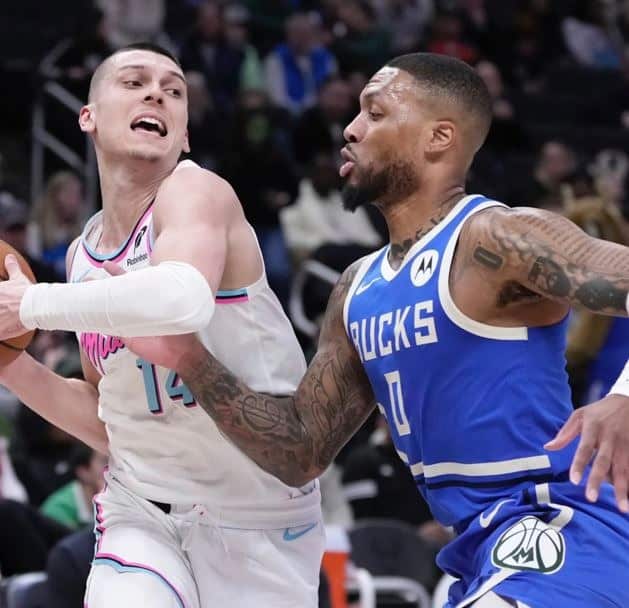#1 The third quarter swing
The Boston Celtics and Oklahoma City Thunder were trading blows throughout the first half. Boston made their runs and kept things close despite the Thunder finding consistent ways to get their shots off and create high-quality looks. However, it was the third quarter where things took a turn, and the Celtics lost ground, which ended up being the major turning point in the game.
The Celtics lost the third quarter by 15 points, with no one in the rotation cracking double-digit scoring. The Thunder, however, dropped 40 points in 12 minutes, with both Josh Giddey and Shai Gilgeous-Alexander finding a rhythm on the offensive end.
What’s worse? As Cameron Tabatabaie pointed out on Twitter, the Celtics won the 1st, 2nd, and 4th quarters in terms of scoring.
Boston outscored OKC 98-87 in the 1st, 2nd, and 4th quarters combined
That 40-25 Thunder 3rd quarter, which featured 16 points from SGA, was what doomed the Celtics
— Cameron Tabatabaie (@CTabatabaie) January 3, 2024
That 15-point swing was a major blow to a Celtics team that had been keeping the Thunder within touching distance for the first two quarters.
#2 OKC set the pace
The Celtics like to play with pace. Yet, there’s a difference between playing at your own pace and having one set for you. For most of the season, the Celtics have been setting the tone during games. They ramp up their speed when required and slow things down when they need to get into some actions.
The Thunder had different ideas, though. They didn’t allow the Celtics to settle into their usual rhythm. Instead, they forced their style of play onto the game, speeding the Celtics up and taking them out of their usual approach to the game. What followed was some fun, break-neck basketball. The downside is that pace favored the Thunder — it’s how they wanted to play, and it’s where they thrive.
It wasn’t until the fourth quarter that the Celtics finally took control of how the game was flowing, and by then, the damage had already been done. They were behind, they were tired, and they were playing an uphill game against one of the best rosters in the NBA (record-wise.)
#3 Brown’s tough night hurt the Celtics
Jaylen Brown has spent the majority of the season operating as a featured scorer within Boston’s system. He’s thriving when attacking the rim. Relentlessly picking his spots in the mid-range. And he’s shown that he can create plays with smart rim-reads and quick decisions as defenses close in on him.
However, playing at the Thunder’s pace against a team that collapsed on his every drive and played physically with him from the jump, Brown struggled to impact the game. He went 4-of-18 from the field (22.2%) and 0-of-8 from three. Stinkers of this magnitude are incredibly rare for Brown, which is why it was such a shock to the system to see him struggling to the extent he did.
Yes, if he had been playing at his usual standard, the Celtics probably would have won against Oklahoma. Yes, we expect more. No, we shouldn’t blame him for the loss or look forget how good he’s been this season. It was a rough game against a defense that set out to stifle him and take him out of the game. The defense succeeded in its mission. Next time Brown faces the Thunder, we should expect a huge response from him.
Still, that performance hurt. On to the next one now.
#4 Kristaps Porzingis won the Unicorn battle
Kristaps Porzingis has had two “Battle of the Unicorn” games this week. First against Victor Wembanyama and the San Antonio Spurs, and then against Chet Holmgren and the Thunder. Porzingis had an off night against Wembanayma but bounced back to be a monster against Oklahoma.
In fact, Porzingis was arguably Boston’s best player throughout the game. Despite being swarmed on by the defense, he found ways to score in the post. He hit his perimeter jumpers. And, when he got to the line, he hit 8 of his 9 attempts.
This is a perfect example of the kind of night Porzingis had. Three defenders are clogging his air space, yet he somehow found a way to get the shot off and convert the attempt. Everything Porzingis did came at his own pace and was in his own flow of the game, which allowed him to somewhat ignore the pressure being sent his way and for his natural game to flow.
Oh, and we can’t forget that he had 3 blocks in the game, too. This one stood out to me.
The Thunder runs two separate “thru” cuts over screens, forcing the Celtics’ weakside defense into rotation and creating an open lane for Vasilije Micic to attack the rim. Porzingis recognizes the threat, rotates over, and gets the block. Great court awareness from the veteran big man.
I also want to give Porzingis props for the second jump on this block.
Getting enough lift to secure the block while flipping your hips on a second jump is incredibly difficult. That’s high-level athleticism that is often overlooked.
#5 Sticking with Pritchard down the stretch
Jrue Holiday wasn’t having his best game. He fell victim to the Thunder’s pace of play and had some sloppy possessions by his lofty standards. As such, Joe Mazzulla made a judgment call, sticking with Payton Pritchard for the entire fourth quarter and limiting Holiday to 3:44 of playing time.
Pritchard had a good game. His ability to switch gears allowed him to keep pace with Oklahoma, while his willingness to fight for rebounds and to get others open kept the Celtics offense ticking. Granted, Pritchard missed both of his shots in the fourth. However, he was making things happen on both sides of the floor, and that impact played a big part in Boston’s late-game comeback.
#6 Horford can steady the ship
When Al Horford is on the court, there always seems to be an air of calmness within the rotation. His ability to defend multiple positions and how rarely he makes a mistake make him the perfect veteran leader coming off the bench.
I chose to use the above clip because I think it illustrates the level of defense Horford provides, especially in terms of cutting off angles and, in this instance, “icing” the ball-handler to protect the middle of the court.
Horford starts the possession by playing up-to-touch on the screen. He then switches onto Micic and takes away the center of the floor. Pay attention to how Horford slides his feet to keep his angle and ensure he’s funneling the ball-handler toward the baseline. When he’s got nowhere left to go, Micic resets by bringing the ball back onto the perimeter.
A dribble hand-off with Holmgren gets Horford switched onto the impressive rookie. However, the outcome is the same. Holmgren does his best to get into the center of the floor, fails in his attempts, and then gives a hand-off back to Micic where Horford then blocks the jumper.
This man is 37 years old. He tallied 5 blocks, 3 assists, 2 rebounds and went 3-of-5 from the field. Horford’s presence has never been based on what the boxscore says. Instead, it’s possessions like the one above that truly show his impact.
#7 Tatum balled out
I liked this game from Jayson Tatum. He was a big part of the energy shift in the fourth quarter. He was getting the ball out of his hands when the defense took away his driving lanes or shooting opportunities, and as has become the norm, he went to work on the glass.
What I liked most is that Tatum is starting to become more judicious with his shot selection. He knows where his spots are, and he’s looking to get them with a higher frequency than we’ve seen before. Take the blow play, for example. The defense takes away his drive. Rather than facing up and forcing another drive or shooting a contested shot, Tatum slows the pace down, drop-steps toward the elbow to create space, then turns and shoots a fadeaway — and we all know that is part of his bag.
It was the same story on the perimeter.
Tatum is better when shooting from the catch. He’s also a little better when firing from the wing. The shot comes in rhythm, and he nails it. Even more impressive, though, was how he used his usual dribble pull-up setup to create an assist early in the game.
Tatum had a solid game on both ends of the floor. If I have time in the coming days, I am hoping to take a closer look at his defense in this game in a separate article.
#8 Gettin’ nerdy with it: The opening play
I liked this play: “Zipper Flex Pop” — you can find the definitions of these actions in the X’s and O’s glossary.
Boston didn’t get the ending they wanted on this possession. However, every part of the action got players to their spots. The zipper cut from Tatum got him the ball in the slot. The flex screen from Brown got Porzingis on the block. And the “pop” put Brown in his most trusty catch-and-shoot spot on the floor.
I really enjoy it when the Celtics open games with a designed play; it sets a good tone for the movement and off-ball screening and, more often than not, has a good result.
#9 Gettin’ nerdy with it: Getting production out of a decoy action
Recently, the Celtics have been finding some success with “chin actions” — I feel like we’ve looked at these a bunch over the past week or two. So, when the Celtics used their “chin” alignment as a decoy to get Tatum into the high post, it shouldn’t have come as a surprise to us.
Rather than cutting off Tatum’s screen, either via the non-ball side (chin) or ball-side (UCLA) White rejects the screen and gets a hand-off from Tatum. From there, Tatum posts up, gets the rock, spins, and boom, a momentum-generating (we hoped at the time) dunk.
Teams scout each other. They know what plays have been having success in recent games. Using that scouting report to generate offense by selling a play you’ve been running is great playcalling by the coaching staff.
#10 The comeback
The Celtics scored 37 points in the fourth quarter. They sliced the lead down and put significant pressure on the Thunder throughout the final 12 minutes. Brown came to life, dropping 9 points, White also had 9, Tatum had 8 and 4 assists. Boston took control of the game by setting the pace and running their actions.
Unfortunately, Oklahoma’s lead proved to be too much for Boston to claw back, despite a big-time late-game performance from the team. However, for me, the fight and desire the Celtics showed, and how they took control of the game when it mattered most, was encouraging. I came away from the contest feeling like this matchup was a good learning tool for the team, and they should be able to beat the Thunder in their next meeting or in a series.
The Celtics have more experience than Oklahoma. Still, the Thunder are a great young team, and Gilgeous-Alexander is exceptional.
Looking Ahead
Today’s takeaways are more positive than some might enjoy. However, I refuse to get down on a team that’s 26-7, top of the Eastern Conference and fought until the final buzzer. Losses happen; I would rather that when they did, they were in a game where the Celtics never gave up — just like this one.
Boston now has two days off before they face the Utah Jazz in front of their home crowd. Until then, enjoy the rest of your week, and we will get back to it with the Takeaways on Saturday!






